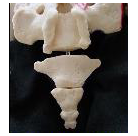- “STIR” images and “T2” images on MRI are essentially like filter settings where fluid shows up bright.
- Some amount of fluid is normal, since many of our body tissues contain significant fluid content (for example, our fat cells [adipose] have significant fluid content).
- Also, we of course have the fluid we call urine within our urinary bladder, and cerebrospinal fluid within our spinal canal, and fluid within our bowels.
- But sometimes the STIR images or T2 images show an *increased* or *abnormal* amount of fluid, or a fluid signal in a place where it is not normally seen.
- Commonly this extra fluid signal is due to inflammation.
- Less commonly it can be things like infection (but that would usually be apparent clinically, meaning that someone would often have other symptoms like fever, redness/warmth of the skin overlying the area, etc.).
- A fluid-filled cyst (such as a pilonidal cyst) would often also show up bright on T2 and STIR images.
- So, where there is increased signal on T2 and STIR images, we often try to figure out whether this is caused by inflammation or if it is caused by something else.
- Overall, the cause is frequently inflammation.
- If we believe that the increased signal was due to inflammation, then the next step is to try to figure out what is causing the inflammation.
- For example, sometimes there will be inflammation at/around a joint that is unstable (coccygeal dynamic instability).
- When there is inflammation around the lowest coccygeal bone, often that can be associated with an underlying bone spur at that lowest tip of the coccyx. But, often the bone spur will be missed if the MRI was not done in a way that included sagittal images in the midline (basically sagittal is an image of what it would look like if we were to slice and someone right down the middle into a left half and the right half). Also, the sagittal images to look for a bone spur would typically need to be done with the “T-1” filter setting, since that is the best MRI filter setting to show bony structures.
- All of this assumes that the radiologist or treating physician took the time to carefully look at the MRI images and to specifically look for these kinds of abnormalities at the coccyx.
- This is especially important in patients with coccyx pain (coccydynia, coccyx pain).
- Here at the Coccyx Pain Center, I see hundreds of new patients per year where their prior imaging studies either failed to include the coccyx at all, or fail to include the correct types of slices, or fail to include the correct filter settings, or where the radiologist and treating physician failed to closely look for these kinds of findings.
- People suffering from coccyx pain should educate themselves about these issues, so that they can better advocate for themselves in getting the best medical care possible, even if their local treating physicians may not be particularly familiar with treating coccydynia.
GET THE BOOK: To get your copy of the book “Tailbone Pain Relief Now!” go to: www.TailboneBook.com or go to Amazon
COME FOR RELIEF: For more information on coccyx pain, or to be evaluated in-person at Dr. Foye’s Tailbone Pain Center in the United States, go to: www.TailboneDoctor.com
– Patrick Foye, M.D., Director of the Coccyx Pain Center, New Jersey, United States.
Latest posts by Patrick Foye, M.D. (see all)
- Coccygectomy: Expected Recovery and Return to Work after surgery for coccyx pain, tailbone pain. - November 28, 2023
- PRP Platelet Rich Plasma or Prolotherapy for Tailbone Pain, Coccyx Pain - October 25, 2023
- Reasons for Normal X-rays and MRI Despite Tailbone Pain, Coccyx Pain - October 3, 2023

